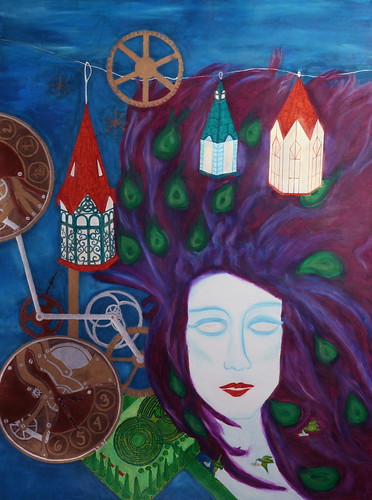
"I do not think that 70 years is the time of a man or woman, nor that 70 millions of years is the time of man or woman, nor that years will ever stop the existence of me, or anyone else."
--Walt Whitman
Saint Lucy decided at an early age that she did not want to be with a man; she preferred to give her self completely to God, though she lived in a time when it was not permitted to follow Christian beliefs. To deflect the attentions of a suitor who was captivated by the beauty of her eyes, she carved them out and sent them to him. Miraculously, she was still able to see--whether with new eyes that God gave her, as in some stories, or by some higher sight, as in others. I have chosen something along the middle path here, giving her the many eyes of a peacock's tail, which serves also as a sort of halo. Lucy also faithfully braved the dangers of guilt by association, regularly taking bread to the Christians that were already in hiding from the authorities. Eventually, she was denounced as a Christian by another spurned suitor, and after various failed attempts, the Roman soldiers succeeded at killing her.
The idea of sight coming from somewhere other than the eyes is one that can be found in many fables, tales, myths, and religions. There are those even in the current scientific community who spend their lives seeking out and testing those who claim to have some other sort of sight-- into the silent thoughts of others, into the future, across great distances, or into other realms where ghosts, angels, and demons reside. It is suggested that the earliest mention of such abilities is found in the Odyssey, but second sight is very common to the lore of the Scottish Highlands and the Icelandic sagas, and precognition is widely accepted among the Native Americans as well as tribes across South Africa and New Zealand.
In The Holographic Universe, Michael Talbot tells the following story about an event concerning a hypnotist his father had hired to entertain at a party and a family friend, named Tom, who agreed to play guinea pig for the evening:
"Tom proved to be a very good subject, and within seconds the hypnotist had him in a deep trance. He then proceeded with the usual tricks performed by stage hypnotists. He convinced Tom there was a giraffe in the room and had Tom gaping in wonder. He told Tom that a potato was really an apple and had Tom eat it with gusto. But the highlight of the evening was when he told Tom that when he came out of trance, his teenage daughter, Laura, would be completely invisible to him. Then, after having Laura stand directly in front of the chair in which Tom was sitting, the hypnotist awakened him and asked him if he could see her.
Tom looked around the room and his gaze appeared to pass right through his giggling daughter. 'No,' he replied...Then the hypnotist went behind Laura so he was hidden from Tom's view and pulled an object out of his pocket. He kept the object carefully concealed so that no one in the room could see it, and pressed it against the small of Laura's back. He asked Tom to identify the object. Tom leaned forward as if staring directly through Laura's stomach and said that it was a watch. The hypnotist nodded and asked if Tom could read the watch's inscription. Tom squinted as if struggling to make out the writing and recited both the name of the watch's owner (which happened to be a person unknown to any of us in the room) and the message. The hypnotist then revealed that the object was indeed a watch and passed it around the room so that everyone could see that Tom had read its inscription correctly." (141)
So, what was Tom seeing the watch with, then? Was he really seeing through his daughter? Or was he seeing the watch by seeing the thoughts in the hypnotist's head? What is that?
While working on this painting, I came across yet another story, this one about an autistic girl, who has of course been subjected to many recorded medical studies since her abilities were noticed. Blind from birth, this girl wanders around by herself without running into things by making little chirping noises which somehow act as a sonar, as in the case of bats.
In this icon of St. Lucy, I have chosen time as that which is being re-envisioned, or seen new. The various clock pieces come apart, reconfigure, and tumble about through space; some of them are organic, forming the labyrinths where the Christians Lucy must feed hide from the monsters, requiring her to find her way by following an inner radiance and sureness of step, that is, by faith and by transcending (thus the birds) her physical handicap.
(Two heavy influences on my thinking about this work, which are linked in my blogroll: Tlon, Uqbar, Orbis Tertius, by Jorge Luis Borges, and How to Create a Universe that Doesn't Fall Apart Two Days Later, by Philip K. Dick).













very engrossing.
ReplyDeletethanks! i'm glad you liked it!
ReplyDelete